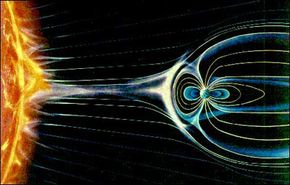What causes auroras?
Auroras are indicators of the connection between the Earth and the sun. The frequency of auroras correlates to the frequency of solar activity and the sun's 11-year cycle of activity.
As the process of fusion occurs inside the sun, it spews high-energy particles (ions, electrons, protons, neutrinos) and radiation in the solar wind. When the sun's activity is high, you'll also see large eruptions called solar flares and coronal mass ejections. These high-energy particles and radiations get released into space and travel throughout the solar system. When they hit the Earth, they encounter its magnetic field.
Advertisement
The poles of the Earth's magnetic field lie near, but not exactly on, its geographic poles (where the planet spins on its axis). Scientists believe that the Earth's liquid iron outer core spins and makes the magnetic field. The field is distorted by the solar wind, getting compressed on the side facing the sun (bow shock) and drawn out on the opposite side (magnetotail). The solar winds create an opening in the magnetic field at the polar cusps. Polar cusps are found on the solar side of the magnetosphere (the area around the Earth that's influenced by the magnetic field). Let's look at how this leads to an aurora.
- As the charged particles of solar winds and flares hit the Earth's magnetic field, they travel along the field lines.
- Some particles get deflected around the Earth, while others interact with the magnetic field lines, causing currents of charged particles within the magnetic fields to travel toward both poles -- this is why there are simultaneous auroras in both hemispheres. (These currents are called Birkeland currents after Kristian Birkeland, the Norwegian physicist who discovered them -- see sidebar.)
- When an electric charge cuts across a magnetic field it generates an electric current (see How Electricity Works). As these currents descend into the atmosphere along the field lines, they pick up more energy.
- When they hit the ionosphere region of the Earth's upper atmosphere, they collide with ions of oxygen and nitrogen.
- The particles impact the oxygen and nitrogen ions and transfer their energy to these ions.
- The absorption of energy by oxygen and nitrogen ions causes electrons within them to become "excited" and move from low-energy to high-energy orbitals (see How Atoms Work).
- When the excited ions relax, the electrons in the oxygen and nitrogen atoms return to their original orbitals. In the process, they re-radiate the energy in the form of light. This light makes up the aurora, and the different colors come from light radiated from different ions.
Note: The particles that interact with the oxygen and nitrogen ions in the atmosphere don't come from the sun, but rather were already trapped by the Earth's magnetic field. The solar winds and flares perturb the magnetic field and set these particles within the magnetosphere in motion.
For more information on auroras, take a look at the links below.
HowStuffWorks Articles
More Great Links
- What causes the Northern Lights?
- What are Northern Lights?
- Exploring the Earth's magnetic field
Sources
- Discoverak.com, What is the Aurora Borealis or Northern Lights?http://www.discoverak.com/what_is_the_aurora_borealis_or_northern_lights.pdf
- Exploratorium: Auroras. http://www.exploratorium.edu/auroras/
- Exploratorium: Auroras: Paintings in the Sky. http://www.exploratorium.edu/learning_studio/auroras/
- NASA GSFC POLAR Brochure. "What Causes the Northern Lights?"http://pwg.gsfc.nasa.gov/polar/EPO/northern_lights/aurora_broch.pdf
- NASA IMAGE Web site.http://image.gsfc.nasa.gov/
- NASA IMAGE, Exploring the Earth's Magnetic Field.http://ds9.ssl.berkeley.edu/themis/pdf/odenwald_mag_lessons.pdf
- NASA IMAGE, The Northern Lights.http://ds9.ssl.berkeley.edu/themis/pdf/nlbook_col.pdf
- NASA MSFC Space Plasma Physics, What is the Magnetosphere?http://science.nasa.gov/ssl/pad/sppb/edu/magnetosphere/bullets.html
- NASA STEREO Home, Space Weather.http://stereo.gsfc.nasa.gov/spaceweather/spaceweather.shtml
- NASA THEMIS Mission, Auroras.http://www.nasa.gov/mission_pages/themis/auroras/index.html
- Nordlys, Northern Lights.http://www.northern-lights.no/english/what/index.shtml
- Petersen, F. "Aurora Borealis - The Northern Lights."http://www.imv.uit.no/english/science/publicat/waynorth/wn1/contents.htm
- Stern, David P. "NASA GSFC, A Teacher's Introduction to the Earth's Magnetosphere."http://www-istp.gsfc.nasa.gov/Education/Cluster1.htm
- Stern, David P. "NASA GSFC, Exploration of the Earth's Magnetosphere."http://www-istp.gsfc.nasa.gov/Education/index.html
- The Viking Answer Lady, The Aurora Borealis and the Vikings.http://www.vikinganswerlady.com/njordrljos.shtml
- Windows to the Universe, Basic Facts About Space Weather.http://www.windows.ucar.edu/spaceweather/basic_facts.html
